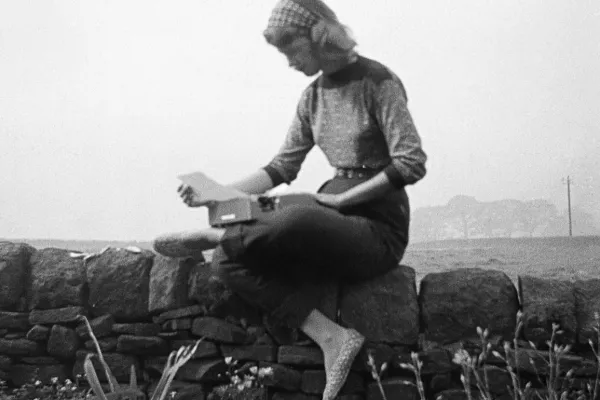Sylvia Plath Letters Reveal a Kaleidoscope of Voices
Research & Inquiry

Published November 15, 2017
On Sept. 28, 1950, the poet Sylvia Plath ’55, in her first semester at Smith, ended a jubilant letter to her mother with the declaration: “I’m so happy…I keep muttering I’M A SMITH GIRL NOW.”
The correspondence is one of 838 personal letters Plath wrote that are now gathered for the 1,388-page The Letters of Sylvia Plath Volume 1: 1940-1956, co-edited by Karen Kukil, Plath scholar and associate curator for Smith’s Special Collections, and Plath archivist and biographer Peter K. Steinberg. The book begins with Plath’s first correspondence as a 7-year-old in 1940 and closes with the last letter Plath wrote in October 1956 before her 24th birthday (and when she was also newly and secretly married to Ted Hughes). Volume 2, featuring Plath’s correspondence from 1957 until her death in 1963, will appear in October 2018.
The project was sparked in 2009 when Kukil began teaching an editing course for Smith’s Archives Concentration. For the class, Kukil and her students transcribed all of Plath’s personal letters in the Smith collections. Steinberg also took part in the course and applied all the same principles to the additional letters he ultimately found in other collections.
“For the next few years, we worked nights, weekends and vacations to assemble this exhaustive manuscript that kept growing as we found more letters,” Kukil says.
The resulting two volumes include every single Plath letter “in existence, that we know of and could locate,” Kukil says. Among them are 16 intimate love letters Plath wrote to Hughes. Those letters, which Kukil describes as “utterly ravishing,” have been included with special permission from Plath’s daughter, Frieda Hughes, who wrote the forward to Volume 1 and still owns the copyright to her mother’s letters.
While preparing to deliver a keynote speech during a Sylvia Plath conference at Ulster University in Belfast, Northern Ireland, in early November, Kukil shared a few thoughts about Plath and her letters.
You are the editor of The Unabridged Journals of Sylvia Plath, published in 2000. How does the voice of Sylvia Plath as it comes forth in The Letters of Sylvia Plath Volume I compare?
“Plath tended to write her more personal thoughts and descriptions in her journals. In her letters she is trying to entertain over 140 recipients and her voice changes accordingly. These letters are absolutely packed with Plath’s firsthand observations of daily life. They are written in her speaking voice. Reading The Letters of Sylvia Plath is like overhearing hundreds of clandestine conversations.”
Does the world of Sylvia Plath, as revealed in a letter, accurately mirror the world outside her view?
“Peter K. Steinberg and I contextualized every person, place and event mentioned in Plath’s letters. There are over 3,600 footnotes between the two volumes of 1,400 letters. Except when Plath is describing her moods and inner emotions, her letters, I believe, are an accurate description of the physical world she experienced in the 1940s through early 1960s in the United States, United Kingdom and Europe.”
What do these letters reveal about Plath that we don’t already know?
“Plath was multitalented and could have pursued many different careers besides creative writing, including journalist, artist, fashion designer and academic. She decided to focus on her creative writing as a career when she was a graduate student at Newnham College, Cambridge. She absorbed everything she read, as well as all the international plays, movies and art shows she attended. All of these influences are carefully traced in the letters and inform her extraordinary creative work. Her professional letters to publishers and literary contacts reveal how ambitious and committed she was to her craft. In addition to her intelligence and creativity, Plath was witty and had a great sense of humor. She was also a very sensual woman. All of these qualities are revealed in her letters.
Who is the Sylvia Plath that you know from poring over her letters?
“We all know the Sylvia Plath fascinated by death, but she also loved every aspect of life and was utterly fearless. Through her vivid, detailed letters we experience her daily life in full color and her hopes for the future. Unfortunately, she just missed the women’s liberation movement and the advances in psychotherapy, which might have helped her survive. Her death is tragic, but her life along the way was full of surprises and many moments of exquisite joy. She also left behind an amazing body of work that continues to be admired and cherished by generations of readers.”
How important will this new work be to scholars?
“Peter Steinberg and I attended the Sylvia Plath 75th-year symposium at Oxford in 2007. Plath scholars at the conference, particularly Linda Wagner-Martin, requested that someone undertake an edition of Sylvia Plath’s complete letters. This was a Herculean task, but Peter and I are particularly happy that we could share Plath’s letters with scholars and finally give Plath the chance to tell her own story, in her own words, at her own pace. Plath’s letters will allow scholars to present a more nuanced version of her life and influences, but they will also allow scholars to analyze mid-20th-century popular culture through the experiences and language of one of America’s most talented writers.”
Sylvia Plath sitting on a stone wall with a typewriter on the Yorkshire moors, September 1956.